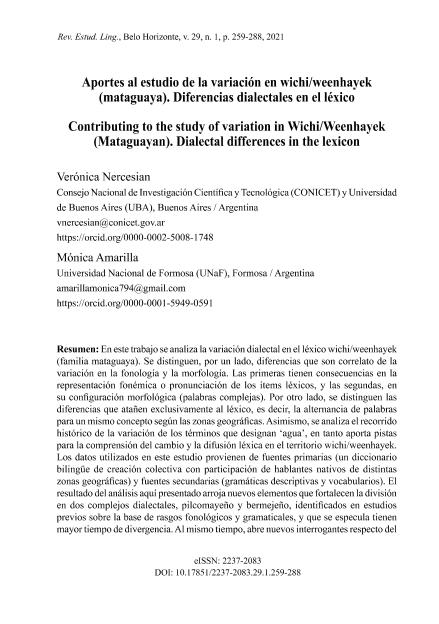Artículo
En este trabajo se analiza la variación dialectal en el léxico wichi/weenhayek (familia mataguaya). Se distinguen, por un lado, diferencias que son correlato de la variación en la fonología y la morfología. Las primeras tienen consecuencias en la representación fonémica o pronunciación de los ítems léxicos, y las segundas, en su configuración morfológica (palabras complejas). Por otro lado, se distinguen las diferencias que atañen exclusivamente al léxico, es decir, la alternancia de palabras para un mismo concepto según las zonas geográficas. Asimismo, se analiza el recorridohistórico de la variación de los términos que designan "agua", en tanto aporta pistas para la comprensión del cambio y la difusión léxica en el territorio wichi/weenhayek. Los datos utilizados en este estudio provienen de fuentes primarias (un diccionario bilingüe de creación colectiva con participación de hablantes nativos de distintas zonas geográficas) y fuentes secundarias (gramáticas descriptivas y vocabularios). El resultado del análisis aquí presentado arroja nuevos elementos que fortalecen la división en dos complejos dialectales, pilcomayeño y bermejeño, identificados en estudios previos sobre la base de rasgos fonológicos y gramaticales, y que se especula tienen mayor tiempo de divergencia. Al mismo tiempo, abre nuevos interrogantes respecto del comportamiento del léxico y la configuración de los complejos dialectales en relacióncon las redes sociales e históricas. This paper analyzes the dialectal variation in the Wichi/Weenhayek language (Mataguayan). On the one hand, we distinguish differences that result from phonological and morphological variations. The phonological variation impacts on the phonemic representation or pronunciation of the lexical items, and the morphological variation impacts on the morphological configuration of the words (complex words). On the other hand, we distinguish differences that have exclusively to do with the lexicon, that is, the alternate words for the same concept distributed in different geographical areas. In addition, we analyze the historical variation of the words for ‘water’, since it gives us hints for the understanding of lexical change and diffusion through the Wichi/Weenhayk territory. The data analyzed in this study come from primary sources (a bilingual Wichi/Weenhayek-Spanish dictionary created collectively together with Wichi native speakers from different geographical areas) and from secondary sources (descriptive grammars and vocabularies). The results of this study contribute new elements to the division into two dialectal groups, Pilcomayeño and Bermejeño, identified previously on the basis of phonological and morphological features, which are speculated as having the longest time of divergence. At the same time, it opens new questions about the behavior of the lexicon and the setting of the two dialectal groups in relation to the historical and social nets
Aportes al estudio de la variación en wichi/weenhayek (mataguaya): Diferencias dialectales en el léxico
Título:
Contributing to the study of variation in Wichi/Weenhayek (Mataguayan): Dialectal differences in the lexicon
Fecha de publicación:
01/2021
Editorial:
Universidade Federal de Mina Gerais. Faculdade de Letras. Programa de Pós-Graduação em Estudos Linguísticos
Revista:
Revista de Estudos Da Linguagem
ISSN:
0104-0588
e-ISSN:
2237-2083
Idioma:
Español
Tipo de recurso:
Artículo publicado
Clasificación temática:
Resumen
Palabras clave:
VARIACIÓN DIALECTAL
,
LÉXICO
,
FONOLOGÍA
,
WICHI/WEENHAYEK
,
MORFOLOGÍA
Archivos asociados
Licencia
Identificadores
Colecciones
Articulos(SEDE CENTRAL)
Articulos de SEDE CENTRAL
Articulos de SEDE CENTRAL
Citación
Nercesian, Verónica; Amarilla, Mónica; Aportes al estudio de la variación en wichi/weenhayek (mataguaya): Diferencias dialectales en el léxico; Universidade Federal de Mina Gerais. Faculdade de Letras. Programa de Pós-Graduação em Estudos Linguísticos; Revista de Estudos Da Linguagem; 29; 1; 1-2021; 259-288
Compartir
Altmétricas




